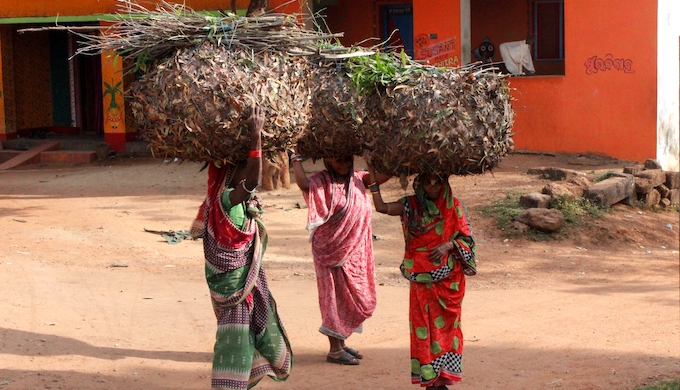As India grapples with high levels of air pollution, especially of particulate matter and noxious gases, latest research indicates that even unborn babies are not spared its ill effects

Women in Mangaljodi village in eastern India return with headloads of dry eucalyptus leaves for cooking from Forest Department plantations (Photo by Manipadma Jena)
Air pollution seems to affect unborn girls more than boys, resulting in more pre-term girls than boys being born when pregnant woman are exposed to extreme air particulate pollution, researchers have found.
In addition to the infant mortality effect, air pollution results in earlier births, more of which are girls, Amir Jina, an environmental economist and Assistant Professor at the Harris School of Public Policy, University of Chicago, said from his yet-to-be-published study on the impact of particulate matter on infant mortality and fertility in developing countries.
“We however need to find out whether this is happening through pollution effects on the foetus itself by air pollution passing through the mother’s blood stream through the placenta to the baby, or if it is something happening to the mother,” he told indiaclimatedialogue.net.
In pregnant women, exposure to carbon monoxide, the major pollutant from vehicles and from wood and kerosene stoves, reduces the availability of oxygen to be transported to the foetus. Carbon monoxide also readily crosses the placenta and binds to foetal haemoglobin more readily than to maternal haemoglobin and is cleared from foetal blood more slowly than from maternal blood, leading to concentrations that may be 10% to 15% higher in the foetus’s blood than in the mother’s, according to several earlier studies.
However, particulate matter — from construction dust, motor vehicle exhaust and biomass fuel burning — cannot cross the placenta.
“Air pollution related infant death, on the other hand, claims more boys,” Jina, a founder of the Climate Impact Lab, said.
“When pregnant women are exposed to highly polluted air, it produces clots in the arteries and in some of the critical blood vessels including the placenta. As the placenta provides oxygen and nutrients to the growing baby during pregnancy, clots can deprive the baby of the flow of nutrients and oxygen and depending on the extent of the clot, they can either abort or have a premature birth,” said Sola Olopade, professor of medicine at the University of Chicago. “When pollution-driven clots are not severe enough but still compromised, babies are born full term but weighed 148 grams less than babies born to mothers who breathed cleaner air.”
More at risk
“Unborn babies exposed to air pollution can have learning and memory development issues,” Olopade said. “They are also at greater risk for chronic diseases such as asthma and cardiovascular disease later in life.”
In his study, Jina has measured the economic burden to individual lives and society in developing countries like India and others when an unborn baby, particularly a girl, survives pollution but is born with health complications that plague them throughout life owing to the pre-birth exposure.
Researching household air pollution impact on unborn babies, Olopade found that 70% exposure to pollutants was from indoor cooking smoke and 30% from outside pollutants, mainly vehicular exhaust.
The impact was very different when mothers cooked with dirty firewood or kerosene and when they cooked using ethanol, a clean biofuel.
Women who cooked with ethanol were more likely to be able to take their pregnancy to full term, significantly more than women who continued cooking with firewood or kerosene. They also had fewer miscarriages, according to Olopade. “We also observed women in the ethanol group had much lower blood pressure closer to delivery, relative to those using polluting cooking fuel. Both groups had normal blood pressure throughout early pregnancy,” he said.

A low-weight baby girl struggles to overcome challenges and survives in a specialized cell in Bhubaneswar city’s government facility, not accessible to rural millions (Photo by Manipadma Jena)
Hypertensive or high blood pressure changes and a co-condition to pregnancies contribuAte to pre-eclampsia, a major cause of death of the mother and the child.
“Pre-eclampsia might be the mechanism affecting the babies’ neurological system and could be the medical reason for more girls being born prematurely to mothers living in polluting environments,” Jina said. “Medical research corroborating these findings have not been robust as yet.”
Pre-eclampsia affects the blood flow to the placenta, often leading to smaller or prematurely born babies. If the pre-eclampsia remains untreated as is likely among India’s rural and poor, it can develop to eclampsia, in which the mother can experience convulsions, coma, and can even die.
Adverse impacts of air pollution on pregnancies was a major topic for interdisciplinary environmental health discussions at a workshop in Delhi held earlier this month by the University of Chicago.
Household toxic air pollution from solid fuel smoke has been associated with a wide variety of adverse health consequences, resulting in an estimated 3.5 million premature deaths and 110 million disability-adjusted life years (DALYs) annually.
More than 40% of the world’s population, which includes 1 billion under-15 children, are exposed to high levels of household air pollution, mainly from cooking with polluting technologies and fuels, WHO said in a recent study.
“Moving away from traditional cooking fuels will lead to improvement in indoor air quality but if the outside air quality remains poor, it may not drive any health benefit,” Olopade said.
In low- and middle-income countries, 98% of all under 5 children are exposed to PM 2.5 levels above WHO air quality guidelines. About 600’000 deaths in of children under 15 years of age were attributed to the joint effects of outdoor and household air pollution in 2016, according to WHO.
But fairly little is even now known about the impact on the lives of a generation of those unborn.











Đăng nhận xét